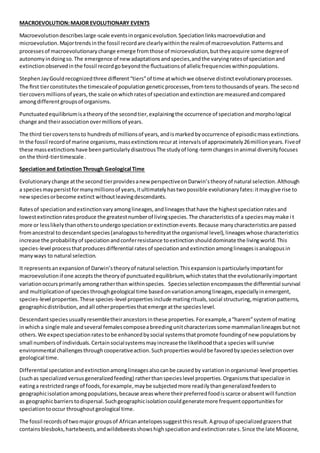
Major Evolutionary Events & Processes
- 1. MACROEVOLUTION:MAJOR EVOLUTIONARY EVENTS Macroevolutiondescribeslarge-scale eventsinorganicevolution.Speciationlinksmacroevolutionand microevolution.Majortrendsinthe fossil recordare clearlywithinthe realmof macroevolution.Patternsand processesof macroevolutionarychange emerge fromthose of microevolution,buttheyacquire some degreeof autonomyindoingso.The emergence of newadaptationsandspecies,andthe varyingratesof speciationand extinctionobservedinthe fossil recordgobeyondthe fluctuationsof allelicfrequencieswithinpopulations. StephenJayGouldrecognizedthree different“tiers”of time atwhichwe observe distinctevolutionaryprocesses. The first tierconstitutesthe timescaleof populationgeneticprocesses,fromtenstothousandsof years.The second tiercoversmillionsof years,the scale onwhichratesof speciationandextinctionare measuredandcompared amongdifferentgroupsof organisms. Punctuatedequilibriumisatheoryof the secondtier,explainingthe occurrence of speciationandmorphological change and theirassociationovermillionsof years. The third tiercoverstensto hundredsof millionsof years,andismarkedbyoccurrence of episodicmassextinctions. In the fossil recordof marine organisms,massextinctionsrecurat intervalsof approximately26millionyears.Fiveof these massextinctionshave beenparticularlydisastrousThe studyof long-termchangesinanimal diversityfocuses on the third-tiertimescale . Speciationand Extinction Through Geological Time Evolutionarychange atthe secondtierprovidesanew perspectiveonDarwin’stheoryof natural selection.Although a speciesmaypersistformanymillionsof years,itultimatelyhastwopossible evolutionaryfates:itmaygive rise to newspeciesorbecome extinct withoutleavingdescendants. Ratesof speciationandextinctionvaryamonglineages,andlineagesthathave the highestspeciationratesand lowestextinctionratesproduce the greatestnumberof livingspecies.The characteristicsof a speciesmaymake i t more or lesslikelythanotherstoundergospeciationorextinctionevents.Because manycharacteristicsare passed fromancestral to descendantspecies(analogoustoheredityatthe organismal level),lineageswhose characteristics increase the probabilityof speciationandconferresistance toextinctionshoulddominate the livingworld.This species-level processthatproducesdifferential ratesof speciationandextinctionamonglineagesisanalogousin manyways to natural selection. It representsanexpansionof Darwin’stheoryof natural selection.Thisexpansionisparticularlyimportantfor macroevolutionif one acceptsthe theoryof punctuatedequilibrium,whichstatesthatthe evolutionarilyimportant variationoccursprimarilyamongratherthan withinspecies. Speciesselectionencompassesthe differential survival and multiplicationof speciesthroughgeological time basedonvariationamonglineages,especiallyinemergent, species-level properties.These species-level propertiesinclude matingrituals,social structuring,migrationpatterns, geographicdistribution,andall otherpropertiesthatemerge atthe specieslevel. Descendantspeciesusuallyresembletheirancestorsinthese properties.Forexample,a“harem”systemof mating inwhicha single male andseveral femalescomposeabreedingunitcharacterizessome mammalianlineagesbutnot others.We expectspeciationratestobe enhancedbysocial systemsthatpromote foundingof new populationsby small numbersof individuals.Certainsocialsystemsmayincreasethe likelihoodthata specieswill survive environmental challengesthroughcooperativeaction.Suchpropertieswouldbe favoredbyspeciesselectionover geological time. Differential speciationandextinctionamonglineagesalsocanbe causedby variationinorganismal-level properties (suchas specializedversusgeneralizedfeeding) ratherthanspecieslevel properties.Organismsthatspecialize in eatinga restrictedrange of foods,forexample,maybe subjectedmore readilythangeneralizedfeedersto geographicisolationamongpopulations,because areaswhere theirpreferredfoodisscarce orabsentwill function as geographicbarrierstodispersal.Suchgeographicisolationcouldgeneratemore frequentopportunitiesfor speciationtooccur throughoutgeological time. The fossil recordsof twomajor groupsof Africanantelopessuggestthisresult.A groupof specializedgrazersthat containsblesboks,hartebeests,andwildebeestsshowshighspeciationandextinctionrates.Since the late Miocene,
- 2. 33 extinctand7 livingspeciesare known,representingatleast18 eventsof branchingspeciationand12 terminal extinctions. In contrast,a group of generalistgrazersandbrowsersthatcontainsimpalasshowsneitherbranchingspeciationnor terminal extinctionduringthissame intervalof time.Interestingly,althoughthese twolineagesdiffergreatlyin speciationrates,extinctionrates,andspeciesdiversity,theydonotdiffersignificantlyintotal numberof individual animalsalive today. PaleontologistElisabethVrba,usesthe term effectmacroevolution todescribe differentialspeciationandextinction ratesamong lineagescausedbyorganismal-level properties.She reservesthe termspeciesselectionforcaseswhere species-level emergentpropertiesare of primaryimportance.Some otherevolutionarypaleontologistsconsider effectmacroevolutionasubsetof speciesselectionbecause fitnessdifferencesoccuramongdifferentspecies lineagesratherthanamongvaryingorganismswithinspecies. Mass Extinctions Whenwe studyevolutionarychange onanevenlargertimesscale,we observe episodiceventsinwhichlarge numbersof taxagoextinctsimultaneously.These eventsare calledmassextinctions. The most cataclysmicof these extinctionepisodeshappenedabout225 millionyearsago,whenatleasthalf of the familiesof shallow-watermarine invertebrates,andfully90% of marine invertebrate speciesdisappearedwithina fewmillionyears.Thiseventwasthe Permian extinction. The Cretaceousextinction,whichoccurredabout65 million yearsago, markedthe endof dinosaurs,aswell asnumerousmarine invertebratesandmanysmall reptiliantaxa. Causesof mass extinctions and evolutionarytimingof massextinctions atintervalsof approximately26millionyears are difficulttoexplain.Some people have proposedbiological explanationsforthese episodicmassextinctionsand othersconsidermanymassextinctionsartifactsof ourstatistical andtaxonomicanalyses. WalterAlvarezproposedthatthe earthwasperiodicallybombardedbyasteroids, causingthesemassextinctions. The drastic effectsof suchbombardmentof aplanetwere observedinJuly1994 whenfragmentsof Comet ShoemakerLevy9bombardedJupiter.The firstfragmenttohitJupiterwasestimatedtohave the force of 10 million hydrogenbombs.Twentyadditional fragmentshitJupiterwithinthe followingweek,one of whichwas25 times more powerful thanthe firstfragment.Thisbombardmentwasthe mostviolenteventinthe recordedhistoryof the solarsystem. A similarbombardmentonearthwouldsend debrisintothe atmosphere,blockingsunlightandcausingdrastic changesof climate.Temperature changeswouldchallenge ecological tolerancesof manyspecies. Alvarez’s hypothesisisbeingtestedinseveral ways,includingasearchfor impactcraters leftbyasteroidsandforaltered mineral contentof rockstrata where massextinctionsoccurred.Atypical concentrationsof the rare-earthelement iridiuminstrataat the Cretaceous-Tertiaryboundaryimplythatthiselemententeredthe earth’satmosphere throughasteroidbombardment. Sometimes,lineagesfavoredbyspeciesselectionare unusuallysusceptible tomass extinction. Climaticchangesproducedbythe hypothesizedasteroidbombardmentscouldproduce selectivechallengesvery differentfromthose encounteredatothertimesinthe earth’shistory.Selective discriminationof particular biological traitsbyeventsof massextinctionistermedcatastrophicspeciesselection. For example,mammalssurvivedthe end-Cretaceousmassextinctionthatdestroyedthe dinosaursandother prominentvertebrateandinvertebrate groups.Followingthisevent,mammalswereable touse environmental resourcesthatpreviously hadbeendeniedthem, leadingtotheiradaptive radiation. Natural selection,species selection,andcatastrophicspeciesselectioninteracttoproduce the macro-evolutionarytrendsseeninthe fossil record.Studiesof these interactingcausal processes have made modernevolutionarypaleontologyanactive and excitingfield.
